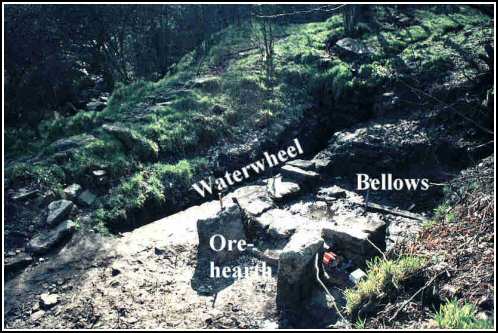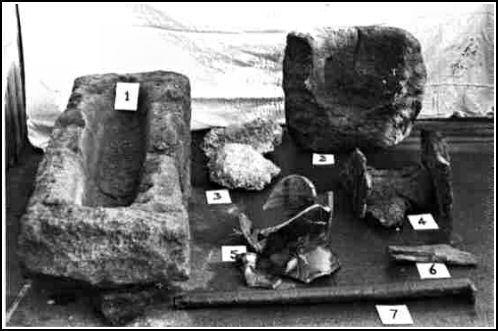LUMB CLOUGH LEAD SMELTING MILL
It is hard to imagine now, but almost 300 years ago there was a lead smelting mill deep in the sylvan setting of Sutton Clough.
To this day, the hillside below Delf House, between the Ellers Road and the Clough, is called Smelt Mill Brow.
The mill, which was an oblong building 16 feet long by 13 feet wide, was split into two rooms. The southern one was the
bellows room and the northern one, called the smelting room, held the ore-hearth in which the lead was made. The mill's location,
on the inside of a 90° bend in Lumb Clough Beck, also gave room for a small dam, but protected it from flood waters which
attacked the opposite bank.
A narrow, 16 foot diameter, overshot waterwheel on the mill's east wall drove the bellows which had a nozzle projecting through
the dividing wall into the back of the ore-hearth. The ore-hearth was a small, open furnace, made from blocks of cast-iron,
not too dissimilar to a blacksmith's forge. In it were placed layers of dried wood, called chop wood, some coal and the lead ore.
When the hearth was lit, the bellows were worked slowly at first so that the sulphur, in the ore, could be burnt off as sulphur
dioxide. This and other fumes were vented through a short, squat chimney directly over the hearth. When this was done, the
smelter increased the air-blast from the bellows, making the fire hotter (about 700° Centigrade) and melting the lead which
ran from the fire. It was collected in a heated pot (to keep it molten) and then ladled into a mould, called a pig pan, where it
was cast into an ingot or piece weighing about 1½ cwts.

General view of the smelt mill during excavation in 1973.
Ore was brought to the mill by pack horse from the mine on Glusburn Moor. Most of the coal came from pits on Rivock Edge and
Howden Gill, near Silsden, but analysis by National Coal Board scientists showed some of it to be much higher quality. The
nearest source of this coal was in the vicinity of Barnsley, over 30 miles away.
The chop wood was most likely cut from trees in the Clough. It was certainly dried there, in a keyhole-shaped kiln which can
still be seen between the mill and the beck. The wood was first debarked and chopped into pieces about 6 inches long by 2 inches
in diameter. It was then stacked in the kiln and dried over a slow fire. Unlike charcoal making, however, where the wood was
converted to pure carbon, the chop kiln simply removed the sap to increase the wood's calorific value.

The chop kiln for drying wood.
Two types of slag were found scattered about the site. The first, called grey slags, came from the ore-hearth and, being rich
in lead, were heavy. The second, called black slags, were a black glass formed when the grey slags were re-smelted at a much
higher temperature (between 1100 and 1200° Centigrade) at which they became molten and released any lead trapped in them.
Analysis of these slags, by the Mining Department of Leeds University and the Department of Archæological Sciences at the
University of Bradford, showed the grey slag to hold around 20 per cent lead and the black slags to hold around one per cent
lead.

Artefacts found during the excavation of Lumb Clough Mill in 1973.
1. Gritstone pig pan.
2. Gritstone sumpter pot (part).
3. Partly smelted lead ore.
4. Part of the wooden trough which brought water to the wheel.
5. Assorted pottery.
6. Part of a wooden shovel.
7. Iron pin from bellows.
THE MINE IN THE CLOUGH
A little known tunnel, around 36 inches high and 30 inches wide, has been driven south-south-west for 325 feet through shale
near the head of the Clough. Nothing is known of its history, but it was most probably driven in search of coal in the late
17th or early 18th centuries. No coal was found, however, and the tunnel should not be explored because it is badly ventilated
and the air lacks oxygen.
Originally contributed by Mike Gill,
President and Recorder of the
The Northern Mine Research Society
and the Sutton-in-Craven Conservation Group.
| 
